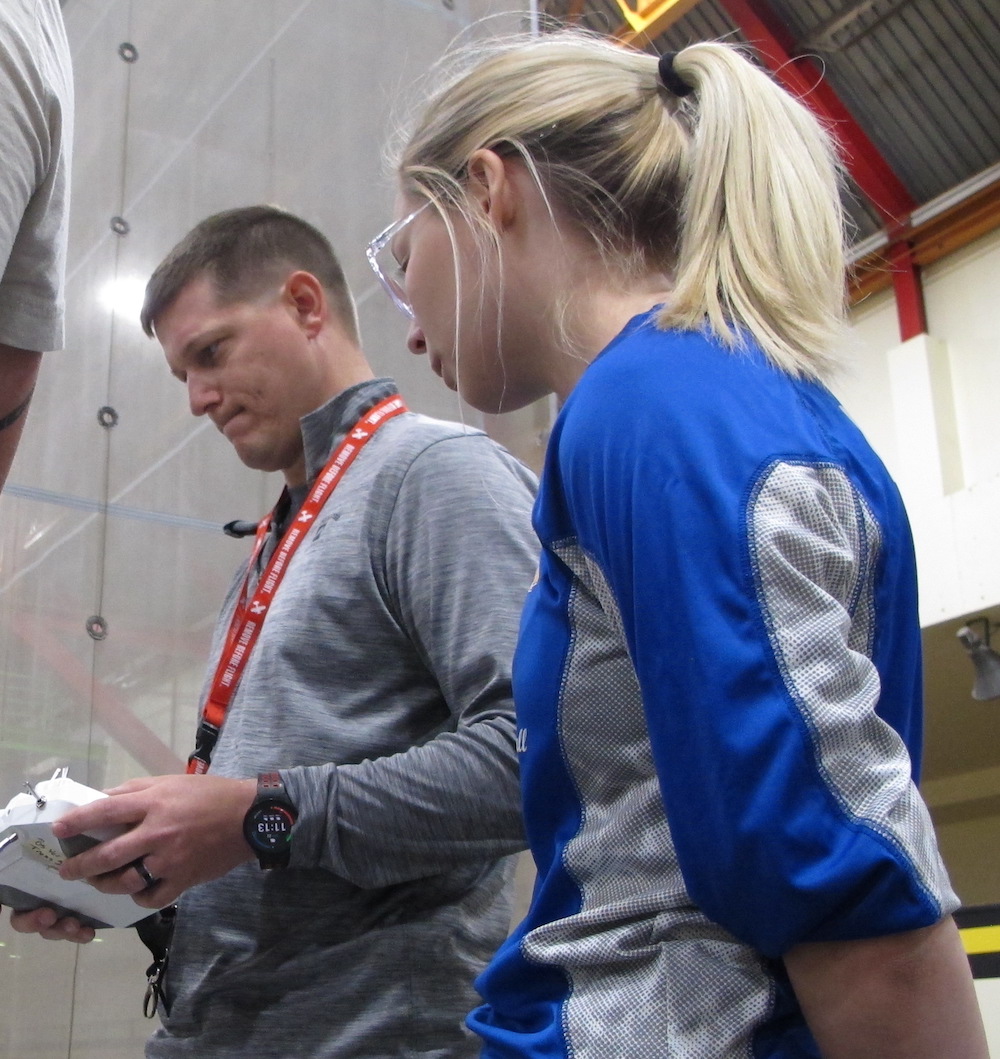About the Competition
The Aerospace Engineering department annually hosts an aircraft design competition, the Bronze Propeller Competition. The goal is to encourage involvement in a fun and educational activity. Competing teams design and build a small electric-powered aircraft to fly a challenging mission. Undergraduate winners get their names on the Bronze Propeller trophy.
2026 Competition Information
Time: May 1st (TBD), 2026 from 10.30 a.m. to 4.30 p.m. Location:Wichita State University Heskett Center
For the 2026 Boeing Bronze Propeller competition, each team needs to design, build, and fly a fixed-wing vehicle that performs a challenging engineering task and creates unique market value that contributes to Large External Payload Carrier and/or Airborne Launch Tasks. A good example is a Boeing B52 mission carrying the X-38 lifting body research vehicle.
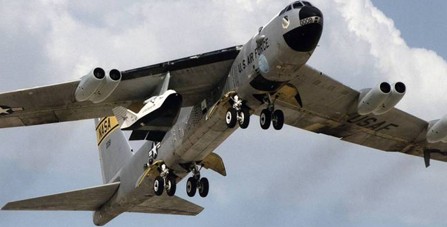
High school, professional and undergraduate teams (non-AE628) must also complete the registration process. See the participation categories and registration tabs below. For further information, contact Dr. Suresh Keshavanarayana.
Besides being attentive to traditional technical work, engineers must also consider public health, safety, and welfare in everything we do. Coincident with this aspect, we need to be mindful of global, cultural, social, environmental, and economic factors. Students often lose touch of the fact that "engineering is not done for its own sake, it is practiced in context" ( McMasters & Cummings, AIAA Journal of Aircraft, Vol. 41, No. 1, January–February 2004).
In summary, young engineers need to be curious of the competition, making connections between the knowledge they have learned and creating products of value. These expectations are an important part of the competition and a foundation for success as a professional engineer.
For the 2026 Boeing Bronze Propeller competition, each team needs to design, build, and fly a fixed-wing vehicle that performs a challenging engineering task and creates unique market value that contributes to Large External Payload Carrier and/or Airborne Launch Tasks.
The vehicle to be designed, built, and flown must be capable of taking off and landing on a conventional runway (32 ft in length and 12 ft wide) and carry external payloads (represented by standard pickle balls weighing 26 grams (0.9oz) each). As part of the competition, each team needs to come up with its own specific mission that creates unique value. This proposed mission must be effectively explained in a well-written abstract before the competition and showcased using a three-fold brochure during the competition. WSU faculties and external judges will review the abstract prior to competition day and score the brochure and team’s 3 minutes pitch during the competition day by considering at least one of the following values:
- Community health.
- Public safety.
- Public well-being or prosperity.
- Impact on a world-wide scale.
- Lifestyles, occupations, religion, wealth, and educational attainment.
- The environment benefits.
- The economy benefits.
To boost your competition score, you can address as many of these values or marketability aspects as possible. The abstract can be viewed as a “sales pitch” to secure approval/funding from your management, government agencies, or private investors. Your airplane configuration should support your mission definition.
The abstract, brochure and team’s project pitch judging criteria include:
1) Uniqueness – what can your design provide that differentiates you from other concepts?
2) Meaningfulness – who is your target customer that can benefit from your design and mission?
3) Investment Return – will your design retain market share/value and benefit your investor?
The abstract and brochure score will directly impact your competition score.
- Fly within an indoor or outdoor area roughly 100 x 200 ft in size, approximately four basketball fields in line.
- Take off and land safely from the conventional runway (32 ft in length, 12ft in width)
- The airplane should have a minimum flight time of 150 seconds and finish a total of 2+2+2 = 6 circles on the flying field.
- The team needs to drop off the payload in a square payload drop-off zone with a 12 ft diameter.
- Multiple Dropoff: Each team must drop off their payload with multiple attempts. Dropping all payload in a single attempt will result in a mission failure and receive a penalty of 10 points.
- Scoring payload must touch down within the drop zone. Payloads missing the drop zone will not be counted for scoring.
- For safe payload drop off, all airplanes must have a stall speed lower than 22 ft/s (15 mph), verified by wind tunnel experiment and flight test prior to the competition.
- A crash landing on the runway (including runway overruns) will result in a penalty of 2 points.
- A maximum of six (6) total payload is allowed. To consider a scoring mission, each team should carry at least two (2) payloads during the mission.
- All payloads must be mounted externally. To be considered as external payload, at least 75% of each payload should be exposed to open air.
- Payloads are represented by standard pickle balls weighing 26 grams (0.9oz) each. The diameter of the pickle ball is 2.9 inches.
- Each team has 60 seconds to set up their airplane at the beginning of the competition. Penalties will be imposed for overtime.
- Bonus Operation 1: Capable of flying at least two additional “figure-eight” patterns with half payload (2 point), full payload (2 points) or empty payload (1 points).
- Bonus Operation 2: Capable of landing on a short runway platform (without ground infrastructure) next to the conventional runway (8 ft wide and 16 ft long) for 2 additional points.
- Bonus Operation 3: Capable of dropping in three (3) attempts for 1 additional point or four (4) attempts for 2 additional points.
- The aircraft must be 100% conceived, designed, and built by team members.
- Teams are required to register and submit a mission description abstract by March 31st (see Registration & Abstract section below).
- The vehicle must be a fixed-wing airplane (no rotorcraft, lighter-than-air, etc.).
- Only a WSU-designated test pilot will fly the airplane.
- Each team has three (3) priority flight attempts for the competition, and the highest score will be recorded for final score calculations. Additional attempts might be available if time permits.
- Flights without returning to the runway will not receive any mission score (excluding landing accidents which will result in penalty points).
- Aircraft can be repaired and flown again between each mission attempt, as long as all rules are satisfied.
- Tape is only allowed for on-site repair during the competition.
- Critical systems and components must be firmly mounted and quickly accessible.
- Aircraft changes during the competition that deviate significantly from the initial design configuration are not permitted.
- A maximum of seven (7) control channels are allowed.
- A maximum of two (2) ESC, Motor, and Propeller assemblies is allowed.
- All servos must be secured and mounted (no Velcro, tape, wire, or adhesive mounting).
- Undergraduate teams have a $450 total budget to purchase all supplies for vehicle building, poster printing and related testing equipment.
- WSU-supplied materials should be considered first. Heavily discounted pre-owned material is available for the first-come-first-get principle.
- For all WSU student teams, accurate team records and receipts are required by competing teams. A mid-semester audit (in Spring) is required for each team. Any external purchase greater than $20 must be approved by the instructor.
- Battery packs must be off-the-shelf purchases and cannot be modified.
- Acceptable battery and ESC connector are listed below. Teams should confirm the battery and ESC connection type before purchase.
- XT-60 (Recommended)
- IC-3
- XT-30
- Anderson Powerpole Connector (Only allowed if using WSU owned materials)
- An ESC with a minimum of 1.25 times the motor peak current must be paired with the motor. (i.e Peak 30A motor should be paired with an ESC rated for 37.5 A)
- The ESC and motor must have 3.5mm bullet connectors. Any other connector type for the motor is not allowed.
- The paired battery discharge rate should be at least 1.5 times the maximum motor peak current.
- Teams can have multiple batteries ready for use during the competition day. However, all batteries must be identical (i.e., of the same manufacture, type, voltage, and milliamp-hours).
- Teams assume all responsibilities in assuming servo, ESC, motor, etc. compatibility.
- Teams assume all responsibilities in assuring propellers properly mount to the motor.
- The plane’s wingspan is limited to a maximum of 40 inches.
- All undergraduate design teams must incorporate a WSU 3x4-ft wind tunnel ATI Mini-45 6-axis balance mounting capability. The 6-axis sensor must be mounted at the longitudinal C.G location of the airplane, with a maximum error of 1 inch.
- The use of foam is allowed. However, the foam used cannot exceed 30% of the wing, tail, or fuselage volume.
- The spar and stringer of the airplane’s wing / tail are encouraged to be made of wood. The spar of the wing could be built out of composite material, but the diameter of composite material cannot reach 3/8 inch or 9.5 mm OD.
- The in-house building and machining of any fiber glass or composite material is NOT allowed. Those materials should be used ‘as purchased’ on your design. If machining is absolutely necessary, you need to have permission from the instructor and the machining has to be done by a professional source.
- 3D-printed components are allowed. However, materials are limited to PLA or tough PLA. Printing costs should be included in your total vehicle cost as well.
- Use of any compressed air, high voltage (max 24V) or high temperature (i.e. steam) component for the ground infrastructure is NOT allowed. Any other design with safety concerns could be disqualified from the competition if the team did not communicate with the AE 628 instructor.
- Planes cannot be flown unless all team members are in a designated safe area.
- There is no default or automatic win if there are three or fewer team category entries.
- In the spirit of the goals of the competition, all rules, requirements, constraints, and scoring aspects are subject to interpretation and change by the WSU AE Department and AE 628 instructor.
- Have fun!
There are three participant categories:
- WSU Undergraduate (1st Place $3,500, 2nd Place $2,500, & 3rd Place $1,500) *
- High School (1st Place $800 & 2nd Place $400) *
- Professional (1st Place $500) *
* Note: Prize money is not automatically awarded when there are a small number of entries in a certain category. Teams must complete the mission and score 8 pts in the competition to be consider for prize money.
Teams with an alumni, past AE 628 student, or graduate student member must participate in the professional category. High school or undergraduate teams cannot elect to compete in the professional category (unless team members scored in the top-three in a previous competition).
Don't be shy. Form a team, build a plane, and fly!
Mentors for high school and undergraduate student teams are recommended. Feel free to contact Dr. Suresh Raju (suresh.keshavanarayana@wichita.edu) for help finding a mentor, borrow critical airplane components, work in the PPL lab, and secure supplies.
The following competition scoring equation applies:
Score = (4 * (np-2)) * AEF * PV * HQ – Pen + Bonus
Where:
- np is the number of payloads dropped and touched down in the drop zone.
- AEF is the Aircraft Efficiency Factor and is defined as:
AEF= (We)-0.5 * (*V * Ah)-0.1
- We are aircraft with empty payload weight in lbs. (including battery and all electronic)
- is the number of batteries.
- V is the manufacturer-rated voltage of the battery
- Ah is the manufacturer-rated battery capacity in Amp. h.
- PV is the product value, determined by the faculty and external judges during the competition day.
-
- PV values range from 0.75 to 1.25, calculated based on the average score from each judge and normalized by the mean and standard deviation of the entire scoring sample.
- PV is evaluated based on the team’s project pitch and brochure design. Four criteria
are used for judging the PV:
- Mission and Design Uniqueness.
- Mission Meaningfulness and Value Created.
- Technical Information and Brochure Quality.
- Professionalism and Design Build Quality.
- HQ is the aircraft handling quality, judged by the pilot during the competition day.
- PV values range from 0.75 to 1.25. The average of the top two scores will be used to determine the scoring of HQ. It is then normalized by the mean and standard deviation of the entire scoring sample.
- The pilot will score each flight using the following criteria.
- Takeoff and landing performance.
- Maneuvering and turning performance.
- Overall aircraft handling sensitivity.
- Pen are the penalties incurred by the team during the competition, which include:
- Crash landing on the runway (including runway overruns) will result in a penalty of 2 pts. Crash landing includes airplane landing upside down or any major component being critically damaged (i.e. broken wing spar, fuselage spar, snapped tail, etc.)
- 1 pts penalty for every 10 seconds of additional time during takeoff preparation and payload loading process.
- Bonus is the bonus maneuver completed by the team, which includes:
- Capable of flying at least two additional “figure-eight” patterns with half payload (2pts) full payload (2 pts) or empty payload (1 pts).
- Capable of dropping in three (3) attempts for 1 additional point or four (4) attempts for 2 additional points.
- Successfully landing on the short runway (8ft wide and 16 ft long) for 2 additional
points.
- Note: Runway overrun on the short runway will result in 0 bonus points and a 2-point penalty. No ground infrastructure allowed.
Teams will be disqualified for their flight attempt if they significantly delay or adversely impact the competition. Specifically, a penalty will be given if:
- The plane leaves the designated flying area.
- The team, in any way, significant delays the competition.
The team can scratch or abort a flight attempt before entering the flying area without a penalty. Be certain your plane is 100% ready to fly before you get into the flight area.
It’s critical to respect competitor plans for multiple flights during the event. Teams that significantly waste time will be disqualified for their current flight attempt.
The sad reality is that crashes happen. However, keep in mind that many teams can quickly repair and fly their planes again. Never give up!
Teams that suffer a crash will not be disqualified unless they unduly delay the competition (e.g., take too long to recover their plane from the flying area). In some cases, teams may be required to wait to recover their crashed aircraft, for safety or other reasons.
Hard landings, with damage, are very common. In such a case, a mission score will not be recorded. Damage that requires more than 30 minutes to repair is considered significant damage and will result in a team disqualification.
A maximum of one additional scoring attempt will be awarded for a team that experiences a minor crash and has not scored any scoring flights after their last regular attempt.
Teams are required to register for the competition and, at the same time, to submit their Mission Description Abstract. The process is easy, simply complete the form and email it to Dr. Suresh Keshavanarayana. The deadline for this document is March 30th.
The Mission Description Abstract should specifically address elements discussed in the Background section. The abstract must fit within the allocated space on the form (with an unchanged 12-pt font and 1-inch margins).
Although we really want you to compete, there is no commitment associated with registering.
Competition day is scheduled for 11:00 am - 4:00 pm Saturday, May 1rd, 2026. (TBD)
Flight Entry: Before entering the competition, each team will first get in the queue line. There will be five queue line tables during the competition day. The first table will be the control check table operated by AE 628 instructor. The second table will be the weight station operated by Quang. Each team has 3 priority flights, meaning that if your team has less than 3 flights, you can get into the queue line anytime. If your team has already completed three flights, you can still get in the queue line, but any team that has completed fewer than 3 flights can jump in front of your team at any time.
Any team that was removed from the flight area (excluding the queue line) due to a lack of readiness (taking too long to set up or being removed by the instructor due to any other reason) will lose the current flight attempt and score a zero point.
When two hours are left in the competition (at 2:00 pm), teams without a successful scoring flight will be given flight-line priority.
Weight Station: A student competition assistant will be weighing all airplanes before entry. We will weigh your airplane using 3 scales. All components, excluding the payload, should be weighed. This includes any additional wrapping and protection of your payload. If your wrapping is difficult to remove during the competition day, we will account for each of your payloads as 26 grams and weigh it with the aircraft, then subtract the weight of the payload. When the weight is complete, the team and the weighing station student worker will sign off the weight recording sheet to confirm the final weight of the aircraft during this attempt.
Control Check Station: The instructor will operate the control check station and give final approval for the team to enter the flying area. The AE 628 Instructor will make sure all control surface operates as desired before the flight. After the control check, the team can leave the battery on. AE 628 Instructor reserves the right to reject any team's entry or remove the team from the flight area if the team is determined as not ready.
Timing: A student competition assistant will record the timing during the competition. For the takeoff setup, the timer will start when the team or the airplane touches the conventional runway, whichever occurs first. A 30-second warning will be provided to the team. After the 1-minute time limit, the team will be notified, and a penalty will be imposed for every 10 seconds of additional time used. If the team fails to set up within 2 minutes, they will be removed from the flight area.
Product Value Judging: Judges will walk around each team's table to talk to each team during the competition. Each team should prepare a 2-3-minute elevator pitch for your project and provide your brochure to the judges. The judges might come in groups or individually, so please be prepared to pitch your project multiple times. All PV judging will end around 1.30 p.m.
Final Score: Depending on the competition day, the final score and winner might not be announced on the competition day. The score will be available on Monday after the competition and will be posted on the Bronze Propeller Website. Awards and competition certificates will be presented to the team during the Engineering Open House. Teams should work with Dr. Raju for the prize money transfer after the week of the Engineering Open House.
Technical Feedback: Due to the nature of the competition, the instructor and the pilot will not provide any technical feedback or suggestions to the team's design. The pilot will only provide qualitative feedback on how the airplane feels during the flight, and the team is prohibited from asking for improvement suggestions during the competition.
Queue Line Final Call:
20 minutes before the end of the competition, a final queue line call will be announced. The queue line will close 15 minutes before the end of the competition and no more team can join the queue line and complete a scoring attempt. All teams that join the queue line before the 15 minutes deadline will be allowed for one final attempt, if the flying space is still available for the competition after the competition end time.
- What's preventing teams from simply copying and pasting (or adapting) a mission for
a team last year?
Using or even slightly modifying previous mission ideas or abstracts is plagiarism and will result in a zero score or disqualification. - Can teams make their own payload?
No – the payload are supplied at the competition. - Are subassemblies, like a premade wing with control surfaces installed, but not assembled
to the fuselage allowed?
Yes – subassemblies are allowed, but the cost should be included in the budget and cannot exceed the maximum budget allowed.
Additional Information or Questions
Contact Dr. Suresh Keshavanarayana with any additional questions.
Past (2025) Bronze Propeller Competition
For the 2025 Boeing Bronze Propeller competition, each team needs to design, build, and fly a fixed-wing vehicle that performs a challenging engineering task and creates unique market value that contributes to Urban Air Mobility (UAM) Tasks.
The vehicle to be designed, built, and flown must be capable of taking off and landing on a short off-ground platform (16 ft in length, 8 ft wide, 4 ft off the ground) and carry payloads (represented by small glass easter egg [2 oz], the egg has a width of 1.5 inches and height of 2.5 inches) that add unique market value to the current UAM market. There are two mission profiles that can be chosen from:
- Payload Dropoff (10 ft x 10 ft Dropoff Zone) and Return.
- Landing at ‘conventional runway’ (50 ft & Ground Takeoff), Payload Pickup and Return.
As part of the competition, each team needs to come up with its own specific mission that creates value for the current UAM market. This proposed mission must be effectively explained in a well-written abstract. External judges will review and score the abstract prior to competition day by considering at least one of the following values:
- Community health.
- Public safety.
- Public well-being or prosperity.
- Impact on a world-wide scale.
- Lifestyles, occupations, religion, wealth, and educational attainment.
- The environment benefits.
- The economy benefits.
To boost your competition score, you can address as many of these values or marketability aspects as possible. The abstract can be viewed as a “sales pitch” to secure approval/funding from your management, government agencies, or private investors. Your airplane configuration should support your mission definition.
Additional abstract judging criteria include:
1) Uniqueness – what can your design provide that differentiates you from other concepts?
2) Meaningfulness – who is your target customer that can benefit from your design?
3) Investment Return – will your design retain market share/value and benefit your investor?
The abstract score will directly impact your competition score.
- Fly within an indoor or outdoor area roughly 100 x 150 ft in size.
- Take off and land safely from the short platform (16 ft in length, 8ft in width, 4 ft off the ground)
- The airplane should have a minimum flight time of 120 seconds and finish a total of 2+1+2 = 5 circles on the flying field.
- For Mission A, the team needs to drop off the payload in a square payload drop-off zone with a
12 ft diameter.
- Airborne Dropoff: Each team is allowed to drop off their payload in multiple passes.
- Scoring payload must 'touch down; within the drop zone.
- 1 point penalty will be added for missing the drop-off zone.
- For Mission B, the team needs to land on a ‘conventional runway’ (50 ft) and reload the aircraft.
The aircraft then needs to ground takeoff from the runway.
- Manually reload: After engine shutoff on the conventional runway, each team has 30 seconds to manually reload the aircraft. The timing starts when the team enters the runway area.
- Auto-reload (5pt bonus): After the aircraft lands on the runway, the team has 2 minutes to pick up the payload without any manual operation other than pilot's input.
- A ground infrastructure is allowed for Mission B on the conventional runway. However, the ground infrastructure cannot be remotely controlled.
- Scoring payload must be attached to the vehicle and undamaged after landing.
- A 24x12 ft backup ground runway will be located next to the STOL platform. The team can choose to land on this ground runway with a penalty of 2 pts.
- Crash landing on the STOL platform or backup runway (including runway overruns) will result in a penalty of 3 pts.
- A maximum of eight (8) total payload is allowed.
- Bonus Operation: Capable of flying at least two additional “figure-eight” patterns with full payload (3 pts) or empty payload (1 pts).
- Payloads are represented by glass easter eggs filled with beans to reach 2 oz/each. The size of the easter egg is approximately 50 mm x 30 mm.
- Protection of the payload is allowed. However, payload protection must be installed on-field within the time limit. Only the number of undamaged payloads will score in the competition.
- Ground infrastructure that helps takeoff and landing on the STOL platform is allowed. Each team has 120 seconds to install the Ground infrastructure, load the payload, and set up the vehicle takeoff configuration before the competition. Permanent mounting (including but not limited to screwing to the runway, gluing to the runway, etc.) is NOT allowed. Any ground infrastructure cost is included in the vehicle's total cost.
The following competition scoring equation applies:
Score = (1+2 * n p) * AEF * PV * HQ – Pen + Bonus
Where:
- n pis the number of payloads dropped or returned without damage.
- AEFis the Aircraft Efficiency Factor and is defined as:
AEF= (W e) -0.3* (nb*V * P) -0.05
- W eare aircraft empty payload weight in lbs. (including battery and all electronic)
- nbis the number of batteries.
- Vis the manufacturer-rated voltage of the battery
- Pis manufacturer-rated battery capacity in Amp. h.
- PVis the product value, determined by the faculty and external judges during the competition
day.
- PV values range from 0.75 to 1.25, calculated based on the average score from each judge and normalized by the mean and standard deviation of the entire scoring sample.
- PV is evaluated based on the team’s project pitch and brochure design. Four criteria
are used for judging the PV:
- Mission and Design Uniqueness.
- Mission Meaningfulness and Value Created.
- Technical Information and Brochure Quality.
- Professionalism and Design Build Quality.
- HQis the aircraft handling quality, judged by the pilot during the competition day.
- PV values range from 0.75 to 1.25. The average of the top two scores will be used to determine the scoring of HQ. It is then normalized by the mean and standard deviation of the entire scoring sample.
- The pilot will score each flight using the following criteria.
- Takeoff and landing performance.
- Maneuvering and turning performance.
- Overall aircraft handling sensitivity.
- Penis the penalties incurred by the team during the competition, which includes:
- Crash landing on the STOL platform or backup runway (including runway overruns) will result in a penalty of 3 pts.
- Landing on the 24x12 ft backup runway will result in a penalty of 2 pts.
- For Mission A, payload missed the drop-off zone will result in a penalty of 1 pt.
- 1 pts penalty for every 10 seconds of additional time during takeoff preparation and payload loading process.
- Bonusis the bonus maneuver completed by the team, which includes:
- Capable of flying at least two additional “figure-eight” patterns with full payload (3 pts) or empty payload (1 pts).
- Auto-reload (5pt bonus): After the aircraft lands on the runway, the team has 2 minutes to pick up the payload without any manual operation.
-
Crash landing is defined if one of the following conditions occurs.
- Landing upside down.
- Runway overrun and not stopped on the platform.
- Landing with a major component broken and the aircraft is not flyable with these broken components. The major components include the wing, fuselage, tail boom, and tail.
- Note: The airplane skin, landing gear, control surface, and propeller are NOT defined as major components. Small scratches or a small number of broken ribs that do not affect the aircraft's overall performance will not count as a crash landing.
2025 Winners
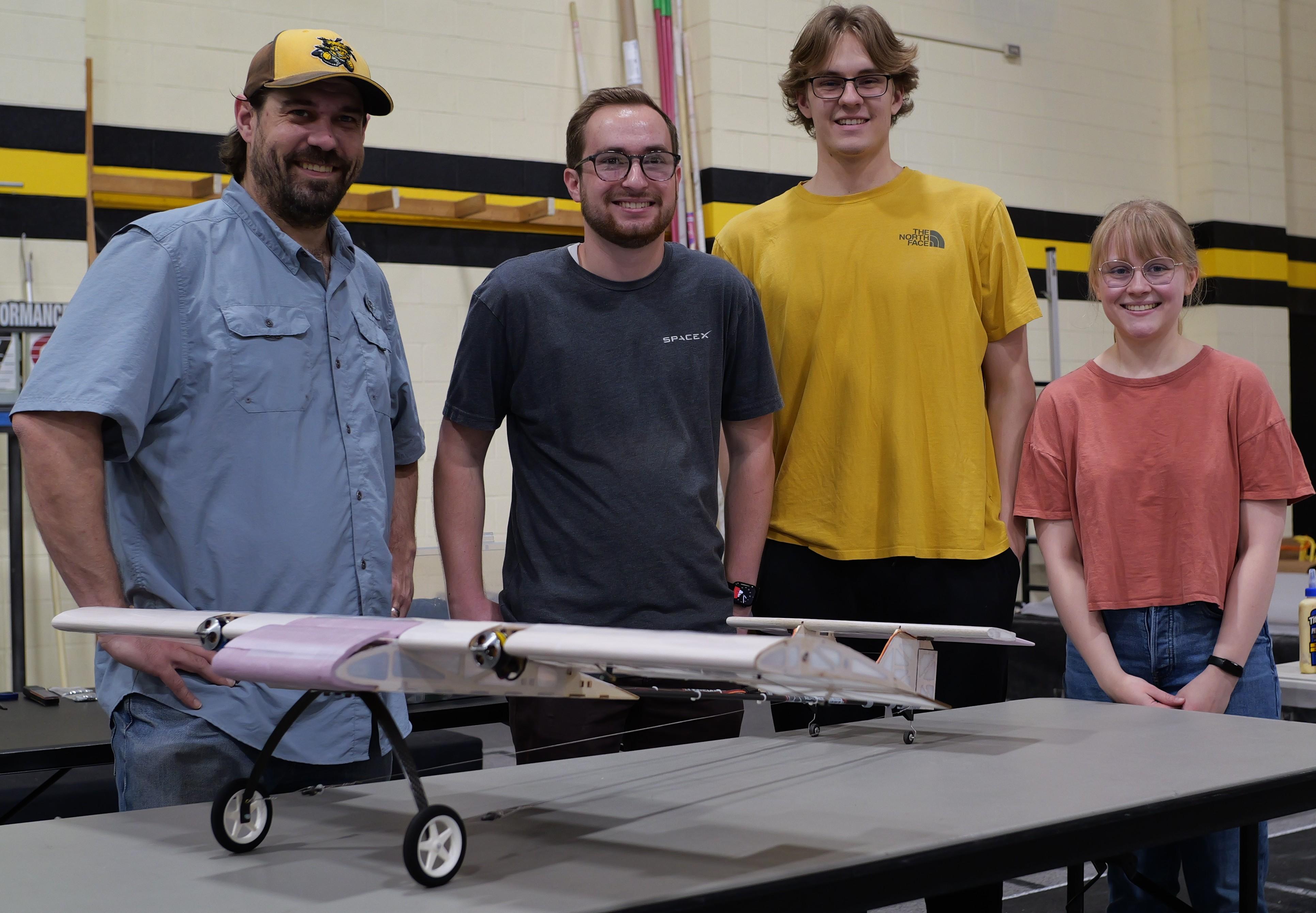
First Place Undergraduate: Team Space Y
Score: 24.88, AEF: 0.636, PV: 1.250, HQ: 1.249, Bonus: 8.0
- Jason Hildreth
- Hunter Robertson
- Zachary Oakley
- Julia McLaughlin
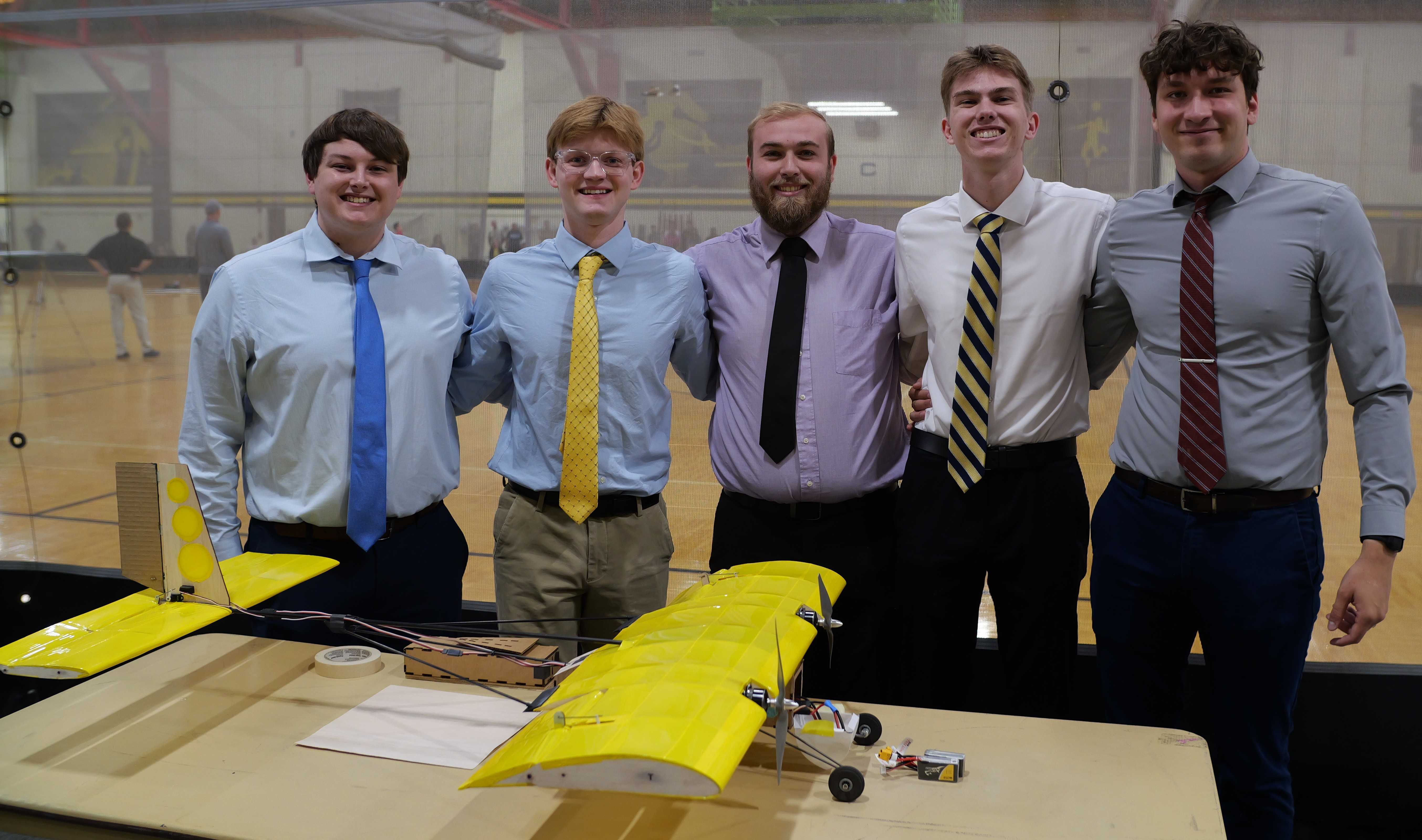
Second Place Undergraduate (Tie): Team Deuces
Score: 24.56, AEF: 0.655, PV: 1.233, HQ: 1.206, Bonus: 8.0.
- Mason Hensley
- Caleb Perkins
- Peter Stuhlsatz
- Joseph Macko
- Zephan Rodriguez
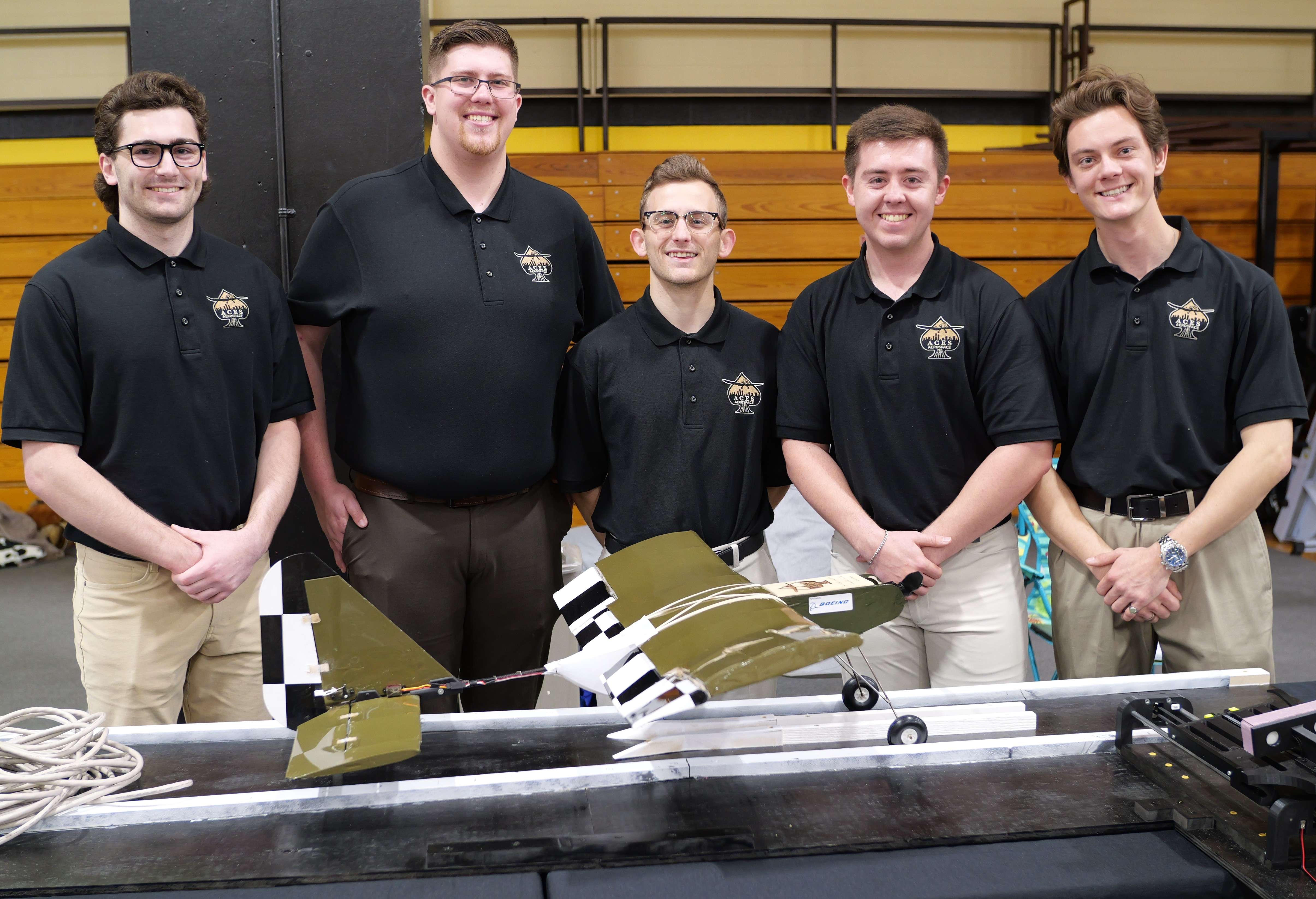
Second Place Undergraduate (Tie): Team Aces
Score: 24.48, AEF: 0.631, PV: 1.245, HQ: 1.235, Bonus: 8.0
- Derek Eitzmann
- Zachary Silvis
- Lucas Baker
- Tracey Hill
- Erik Andersen
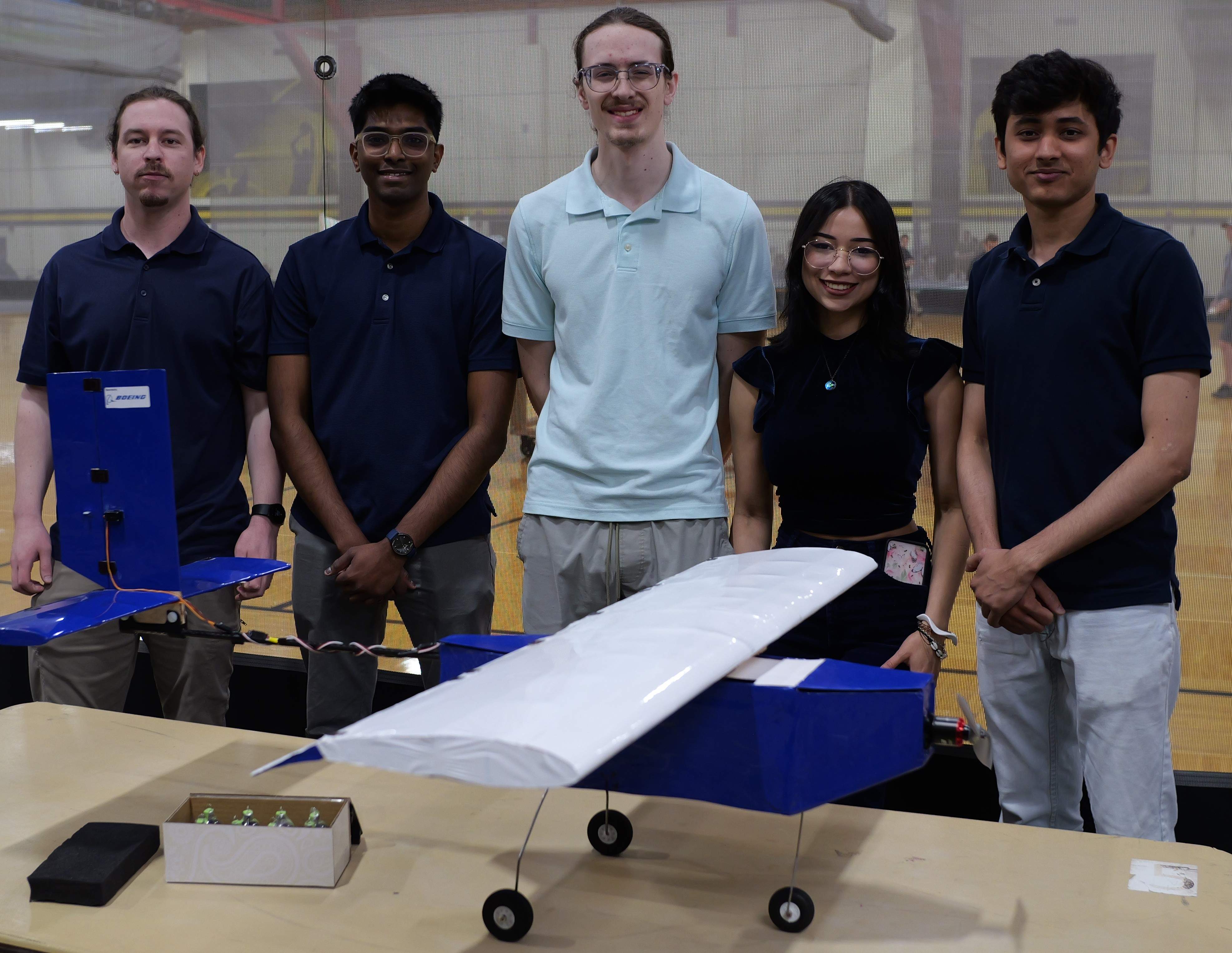
Third Place Undergraduate: Team STARFLEET
Score: 19.54, AEF: 0.649, PV: 1.226, HQ: 1.222, Bonus: 3.0
- Tyler Shuford
- Phanindar Pokala
- Kody Sudol
- Laura Santos
- Darsh Choksi
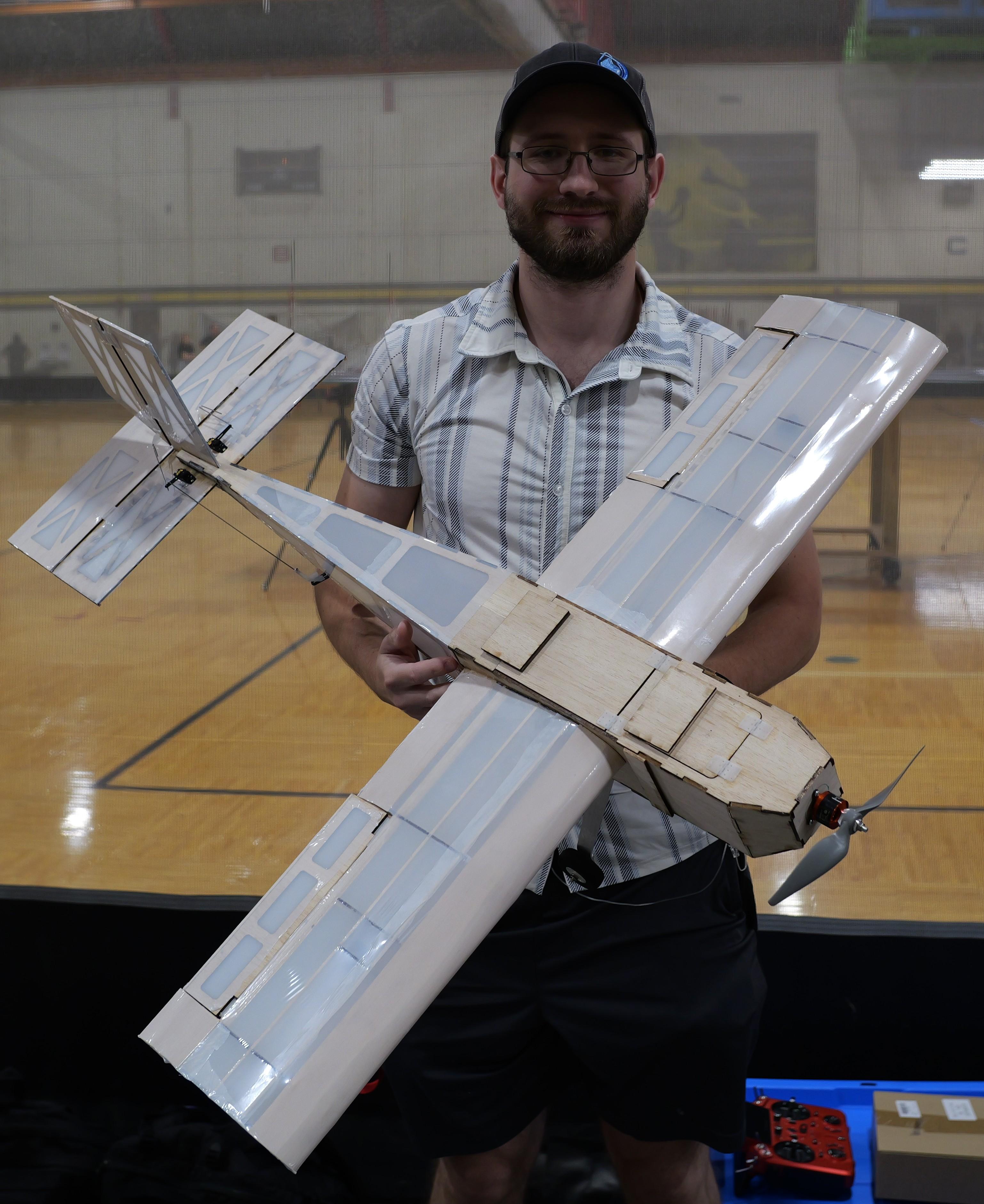
First Place Professional: Team Rabbit Recovery
Score: 16.10, AEF: 0.774, PV: 1.008, HQ: 1.138
- Fischer Simoncic
Past (2024) Bronze Propeller Competition
The 2024 competition was for a heavy lift transportation aircraft that carries two removable “tanks” containing liquid.
For the 2024 Boeing Bronze Propeller competition, the team need to design and build a vehicle that performs a challenging engineering task and has market value.
The vehicle to be designed, built, and flown must transport removable “tanks” containing liquid. The tanks are represented by two 20 oz. plastic Gatorade bottles. Further details on the payload are presented in the rules and requirements section.
As part of the competition, each teamneeds to invent a context within which their vehicle has broad and ideally, marketable value. This supposed mission must be effectively explained in a well-written abstract. External judges will review and score the abstract prior to competition day by considering the following:
“Does the product have a favorable impact on?”
- Community health
- Public safety
- Public well-being or prosperity
- A world-wide scale
- Different cultures
- Lifestyles, occupations, religion, wealth, and educational attainment
- The environment
- The economy
To boost your competition score, you need to address as many of these values or marketability aspects as possible. Although, the “tanks” will contain water for the flight competition, you may assume the “tanks” contain any type of liquid you want to support your mission definition. Do a good job both inventing and communicating your mission. The abstract can be viewed as a “sales pitch” to secure approval/funding from your management, government agencies, or private investors. Your airplane configuration should support your mission definition. Some things to keep in mind: 1) know your competition – why is your product a better value, 2) investors expect a good return on investment – why will customers buy your product, 3) what is your target customer base. There are other considerations as well. Don’t limit yourselves. The “perceived value” score that you receive from the judges on your abstract will directly impact your competition score.
2024 Winners
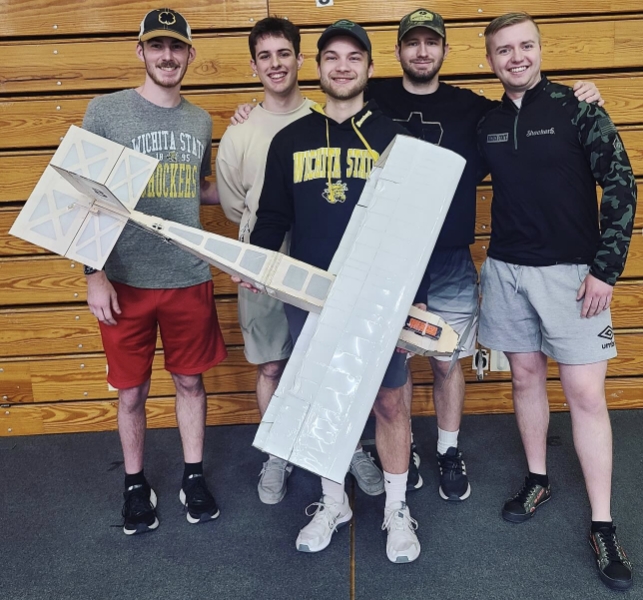
First Place Undergraduate: Team 8
- Fischer Simoncic
- William Shropshire
- Justin Nichols
- Cameron Holston
- Buckley Bischel
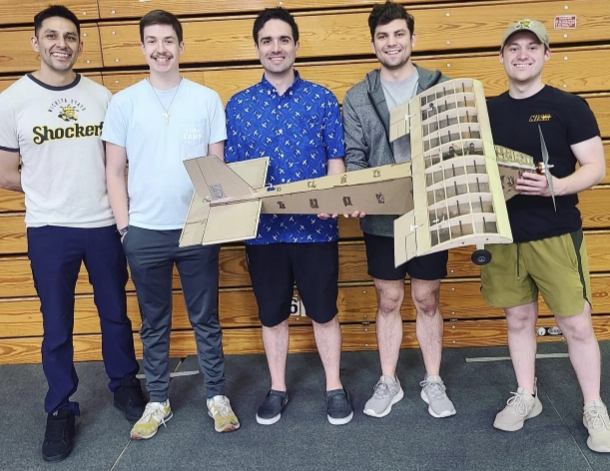
Second Place Undergraduate: Team 5
- Logan Cox
- Nathan Jenkins
- RJ Kunde
- Nick Rodriguez
- Evan Weaver
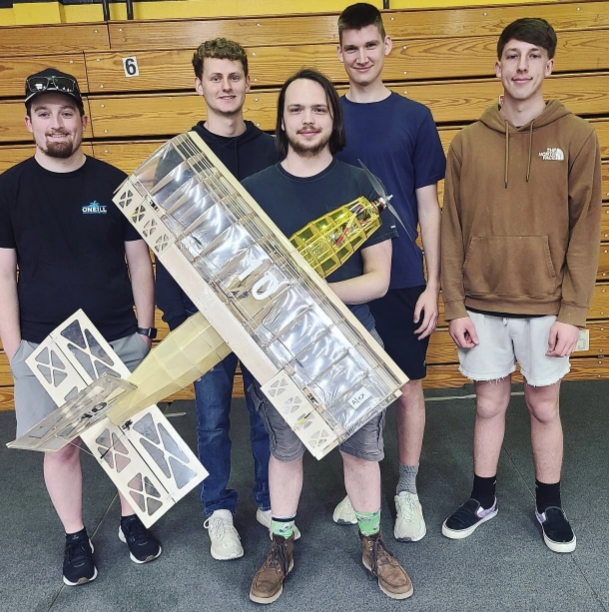
Third Place Undergraduate : Team 10
- Joseph Anglin
- Gabriel Kessler
- Dane Moorhead
- Andrew Noone
- Alexander Schafer
Past (2023) Bronze Propeller Competition
The 2023 competition was for a small "marketable light delivery airplane."
For the 2023 Boeing Bronze Propeller competition, you need to design and build a vehicle that performs a challenging engineering task and has market value.
The engineering part of the competition is relatively simple. The vehicle needs to be light, quick to build, and drop a payload accurately.
Additionally, you need to invent a context within which your vehicle has broad and, ideally, marketable value. Then you have to effectively explain the mission in a well-written abstract. External judges will review and score the abstract prior to competition day by considering the following:
“Does the product have a favorable impact on?”
- community health
- public safety
- public well-being or prosperity
- a world-wide scale
- different cultures
- lifestyles, occupations, religion, wealth, and educational attainment
- the environment
- the economy
To boost your competition score you need to address as many of these value or marketability aspects as possible. Do a good job both inventing and communicating your mission.
The contest included:
- 12 teams, 11 undergraduate and 1 professional
- 81 flights or attempted flights
- An average MAT of 72
- An average PV of 5.3
- An average Wo of 0.91 pounds
- 5 planes with Wo less than 1.0 pound
- 18 target HITS, by 5 teams
- 2 teams had 6, or more, HITS each
- The winning undergraduate team scored HITS on 60% of their flights
- The winning professional scored HITS on 73% of their flights
- 35 payload drops that missed the target
- Only 2 penalties assessed
- A great crowd, of faculty, staff, students, friends, and family
2023 Winners
This was an extremely challenging competition. The difficulty teams had hitting the target was not anticipated in the contest planning stage. Since we didn’t want to disqualify seven teams, both competition Score and HITS are considered. Hence, second and third-place ties are being awarded.
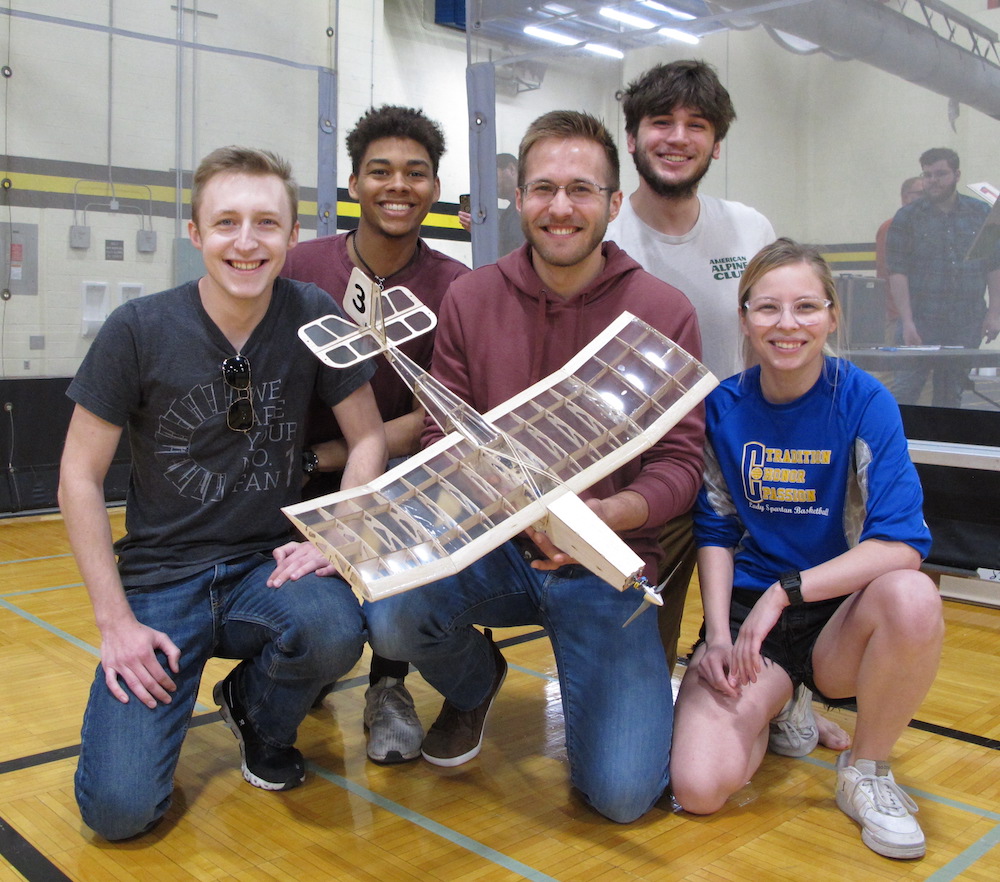
First Place Undergraduate: Team 3
Score=35.2 MAT=38, PV=5.8, W=0.56, P=0, & HITS=6
Comprised of (L-to-R):
- Logan Mauch
- Gabriel Kimuri
- Alexander Dewerff
- Trent Oberlander
- Amanda Mudra
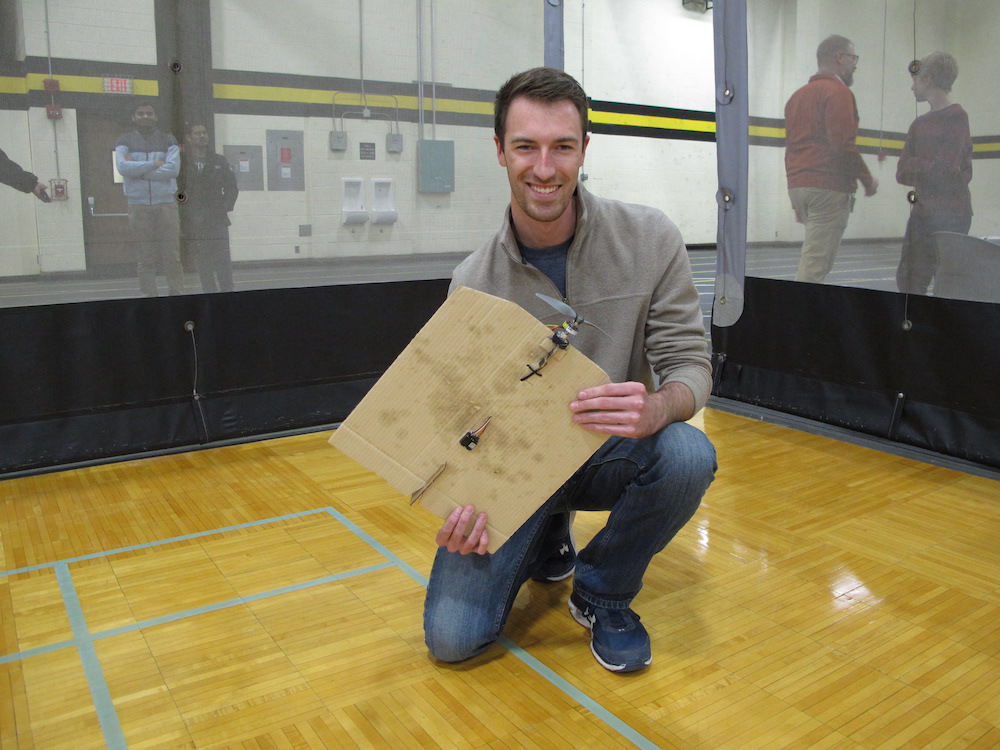
Second Place Undergraduate (tie): Team 15
Score=34.3 MAT=19, PV=2.4, W=0.53, P=0, & HITS=0
Comprised of:
- Robert Ross (with an old pizza box converted into a plane)
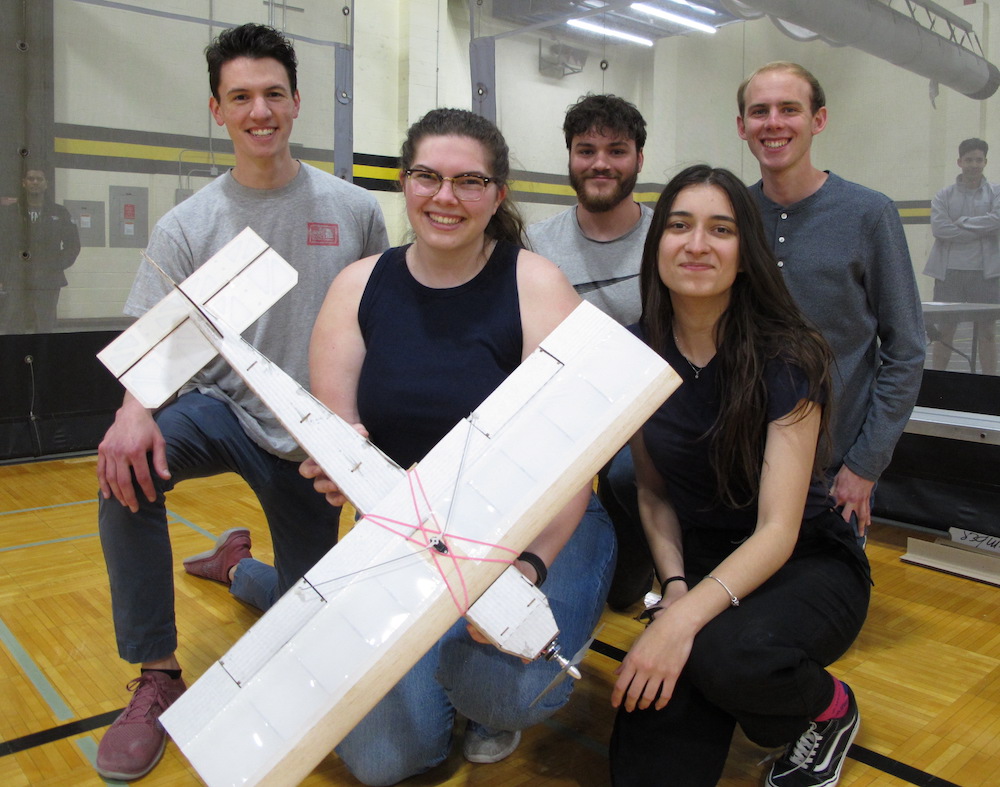
Second Place Undergraduate (tie): Team 15
Score=21.2 MAT=39, PV =5.8, W=0.73, P=0, & HITS=2
Comprised of (L-to-R):
- Benjamin Griffin
- Megan Drake
- Brycen Schroeder
- Sofia Bahr Konkel
- Jackson Caldwell
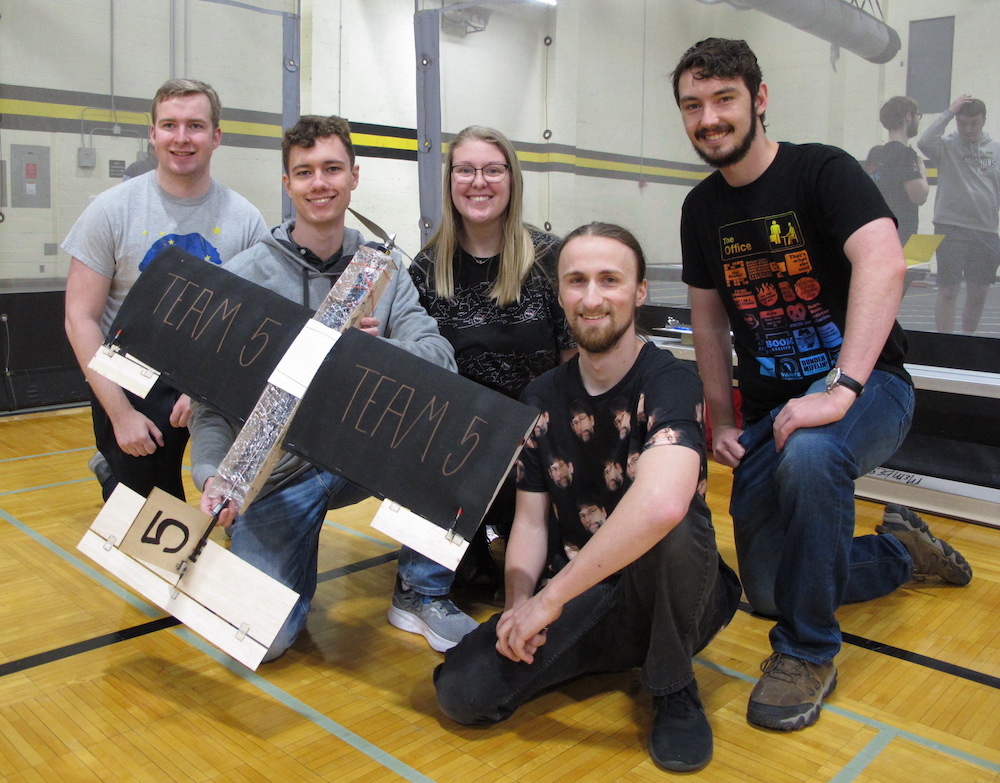
Third Place Undergraduate (tie) - Team 5
Score=15.5 MAT=24, PV =6.0, W=1.13, P=1, & HITS=0
Comprised of (L-to-R):
- Nathan Wahlstedt
- Samuel Lindow
- Kayla Wyrick
- Nathaniel Richardson
- Nathan Kulhanek
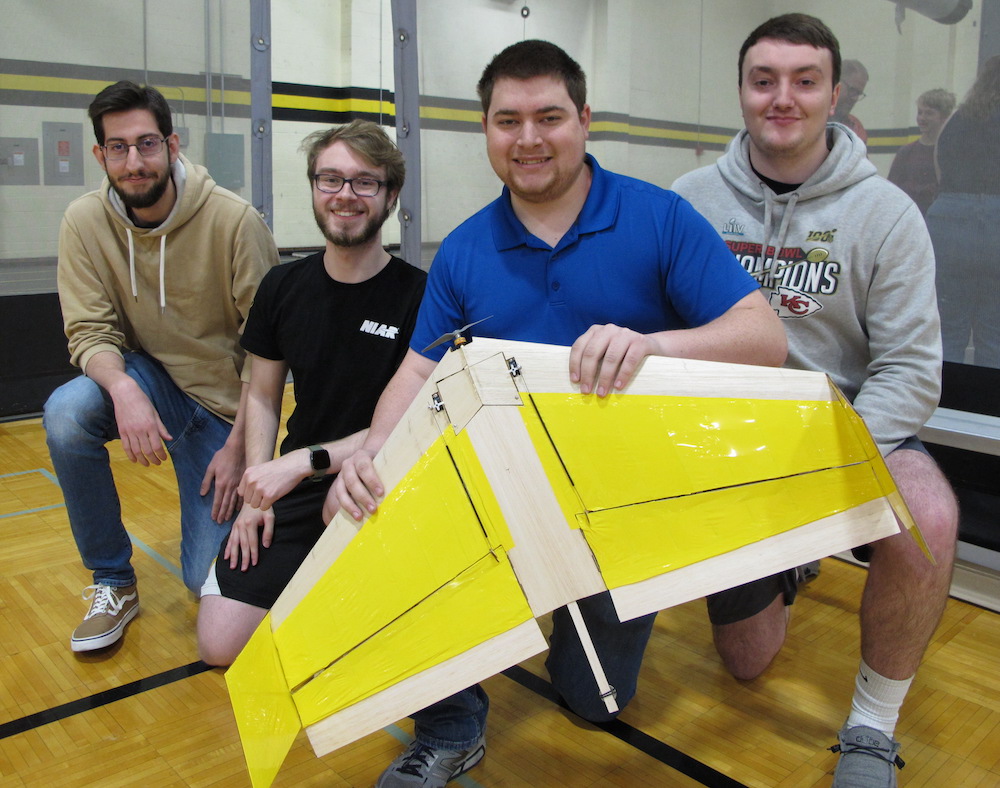
Third Place Undergraduate (tie) - Team 10
Score=13.7 MAT=85, PV =5.9, W=0.76, P=0, & HITS=1
Comprised of (L-to-R):
- Jared Fournier
- Cade Mansfield
- Kale Macormic
- Cameron Cropper
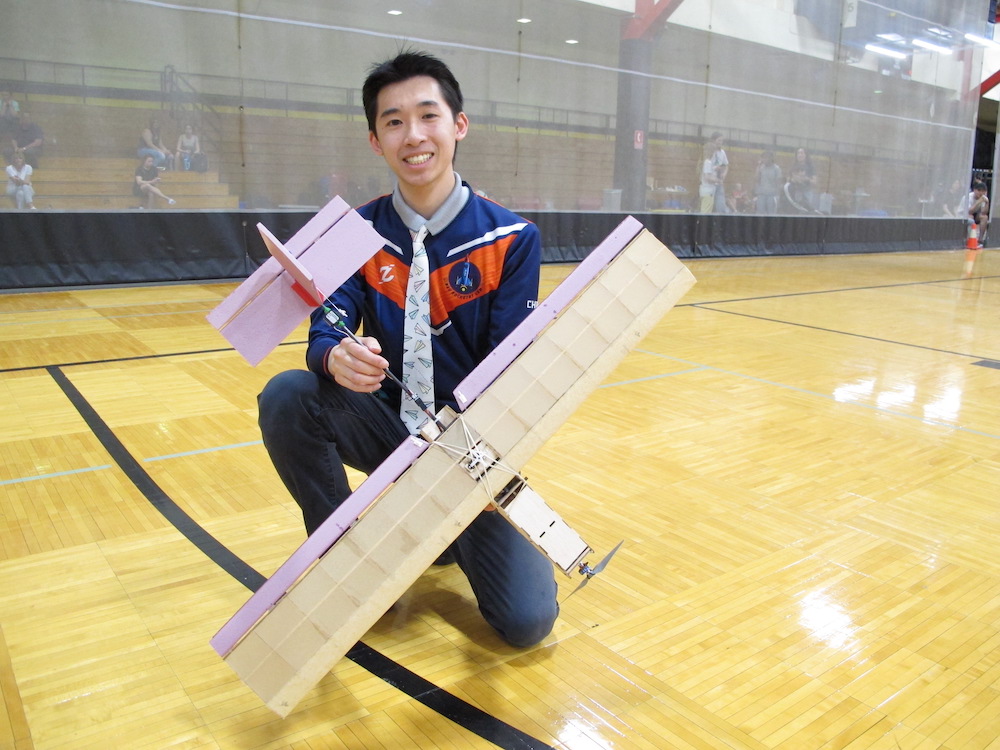
First Place Professional - Team 13
Score=41.9 MAT=58, PV =6.1, W=0.46, P=0, & HITS=8
Comprised of:
- Julian Chee, a WSU AE Alum
2025 Support
Once again, Boeing was the competition sponsor.

We would also like to thank:
- Dean Anthony Muscat who served as the timer.
- Dr. Buerge who weighed planes.
- The AE lab staff got everything ready and helped (special recognition goes to Amanda, Megan, Joey, and Manny).
- Jonathan Mowrey, the pilot, who is a WSU AE alum, Spirit employee and loyal friend of our program, students, and the university, as well as the “Best dang pilot in the solar system."




